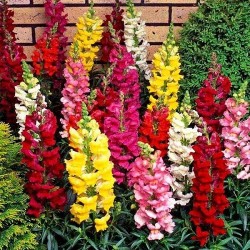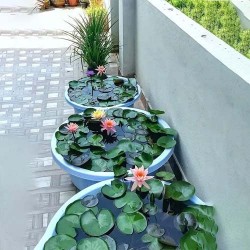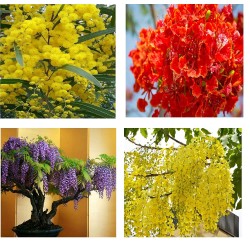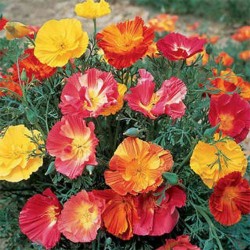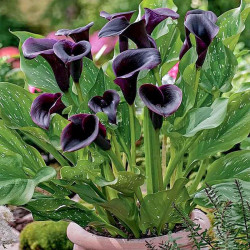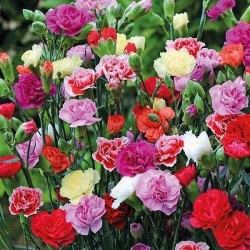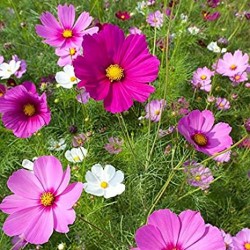Flower Seeds for Home Garden Online Cash on Delivery
- Buy online in India with cash on delivery.
- Variety of All seasonal Flower Seeds for Terrace garden/Home Garden growing.
- Hanging Flower Seeds, Creeper Flower Plant Seeds many other varieties for sale.
Gardening has always been a therapeutic activity, but in today's world, it has become more important than ever. During the pandemic, many of us were looking for ways to stay connected to the natural world while staying safe at home. If you are a nature lover who wants to bring some color and life into your surroundings, planting your own garden is the perfect solution. And now, with the convenience of online shopping, you can easily purchase flower seeds to start your garden from the comfort of your own home. Not only is this a great way to stay productive during these uncertain times, but it is also a wonderful opportunity to create a beautiful outdoor space that you can enjoy all year round. And with the added benefit of cash on delivery, you can rest assured that your purchase will be safe and secure. So why wait? Start browsing for flower seeds online today and get ready to create a stunning garden that will brighten up your life and your surroundings!
Flower Sowing Calendar for India
North India
- Climate: North India experiences hot summers and cold winters, with distinct seasonal changes.
- Sowing Seasons:
Winter Sowing (October to January):
- Alyssum, Aster, Calendula, Carnation, Cineraria, Dahlia, Dianthus, Gaillardia, Gazania, Godetia, Helichrysum, Hollyhock, Kochia, Lakspur, Lupin, Marigold (All varieties), Nasturtium, Pansy, Petunia, Phlox, Poppy, Antirrhinum (Snapdragon), Sweet Peas, Sweet William, Viola Pancy, Verbena, Zinnia, Nemesia, Sweet Sultan.
Summer Sowing (March to June):
- Marigold (French, Jafri), Kochia, Zinnia, Gaillardia.
East India
- Climate: The eastern region has a humid subtropical climate with a strong monsoon season.
- Sowing Seasons:
Winter Sowing (October to January):
- Alyssum, Aster, Calendula, Candy Tuft, Carnation, Cineraria, Dahlia, Daisy, Dianthus, Godetia, Hollyhock, Marigold (All varieties), Nasturtium, Pansy, Petunia, Phlox, Poppy, Antirrhinum (Snapdragon), Sweet Peas, Sweet William, Viola Pancy, Verbena, Zinnia, Nemesia, Sweet Sultan.
Summer Sowing (March to June):
- Zinnia, Marigold (French, Jafri), Kochia, Gaillardia.
West India
- Climate: West India is characterized by a dry and hot climate, with mild winters and strong monsoons.
- Sowing Seasons:
Winter Sowing (October to January):
- Alyssum, Aster, Calendula, Carnation, Cineraria, Dahlia, Daisy, Dianthus, Godetia, Hollyhock, Marigold (All varieties), Nasturtium, Pansy, Petunia, Phlox, Poppy, Antirrhinum (Snapdragon), Sweet Peas, Sweet William, Viola Pancy, Verbena, Zinnia, Nemesia, Sweet Sultan.
Summer Sowing (March to June):
- Zinnia, Marigold (French, Jafri), Kochia, Gaillardia.
South India
- Climate: South India has a tropical climate with a relatively consistent temperature throughout the year.
- Sowing Seasons:
Winter Sowing (October to January):
- Alyssum, Aster, Calendula, Candy Tuft, Carnation, Cineraria, Dahlia, Daisy, Dianthus, Godetia, Hollyhock, Marigold (All varieties), Nasturtium, Pansy, Petunia, Phlox, Poppy, Antirrhinum (Snapdragon), Sweet Peas, Sweet William, Viola Pancy, Verbena, Zinnia, Nemesia, Sweet Sultan.
Summer Sowing (March to June):
- Zinnia, Marigold (French, Jafri), Kochia, Gaillardia.
- Most flowers, such as Alyssum, Aster, Carnation, Cineraria, and Marigold, should be sown in winter across all regions of India.
- Zinnia, Marigold (French, Jafri), Kochia, and Gaillardia are well-suited for summer sowing.
This calendar provides guidance for the best times to plant these flowers, ensuring vibrant and healthy blooms in your garden throughout the year, depending on the region.
Benefits of buying flower seeds online
Buying seeds online is a great option for any gardener. When you purchase seeds online, you have access to a wider variety of seeds than you would at a local store. You can also find seeds that are not available in your area. Another benefit of buying flower seeds online is that you can compare prices and read reviews from other gardeners before making a purchase. Many online stores offer free shipping or discounts for bulk purchases, which can save you money in the long run. Additionally, buying flower seeds online is convenient and saves you time. You can order your seeds from the comfort of your own home, and they will be delivered right to your doorstep.
Cash on delivery option for buying flower seeds online
Cash on delivery (COD) is a popular payment method for online purchases in many countries. It allows you to pay for your purchase when it is delivered to you, rather than paying in advance. This is a great option for those who are wary of using their credit cards online or for those who prefer to pay in cash. Many online stores offer COD as a payment option, including those that sell flower seeds. So, if you want to buy flower seeds online but don't want to use your credit card, look for stores that offer COD as a payment option.
How to choose the right flower seeds for your garden
Choosing the right flower seeds for your garden is important if you want to create a beautiful and healthy garden. The first step is to determine the amount of sunlight your garden receives. Some flowers require full sun, while others can tolerate partial shade. Next, consider the soil type and pH level in your garden. Some flowers prefer well-draining soil, while others can tolerate heavy clay soils. You should also consider the climate in your area and the length of your growing season. Some flowers are annuals and need to be replanted each year, while others are perennials and come back year after year. Finally, consider the colors and sizes of the flowers you want to plant. Choose colors that complement each other and consider the height and spread of the plants to ensure they will fit in your garden space.
Tips for planting flower seeds at home
Planting flower seeds is an easy and rewarding process. Here are some tips to help you get started:
1. Read the instructions on the seed packet carefully before planting.
2. Choose the right location for your seeds based on the amount of sunlight and soil type.
3. Prepare the soil by removing weeds and rocks and adding compost or fertilizer if needed.
4. Plant the seeds according to the instructions on the seed packet.
5. Water the seeds immediately after planting and keep the soil moist but not too wet.
6. Protect the seeds from pests and animals by using netting or fencing if needed.
7. Keep track of the germination process and thin out seedlings if necessary to prevent overcrowding.
Common mistakes to avoid when planting flower seeds
There are some common mistakes that gardeners make when planting flower seeds. Here are a few to avoid:
1. Planting the seeds too deep or too shallow. Follow the instructions on the seed packet for the proper planting depth.
2. Overwatering or underwatering the seeds. Keep the soil moist but not waterlogged.
3. Planting the seeds too close together. This can lead to overcrowding and stunted growth.
4. Failing to protect the seeds from pests and animals. Use netting or fencing to protect your seeds from birds, squirrels, and other pests.
5. Not thinning out seedlings. If you have too many seedlings growing in one area, thin them out to prevent overcrowding.
Best flower seeds for beginners
If you are new to gardening, it's best to start with easy-to-grow flower seeds. Here are some of the best flower seeds for beginners:
1. Sunflowers: Sunflowers are easy to grow and come in a variety of sizes and colors.
2. Marigolds: Marigolds are low-maintenance and come in bright colors.
3. Zinnias: Zinnias are easy to grow and come in a variety of colors and sizes.
4. Cosmos: Cosmos are easy to grow and require little maintenance.
5. Nasturtiums: Nasturtiums are fast-growing and come in a variety of colors.
Best flower seeds for different types of gardens
Different types of gardens require different types of flowers. Here are some of the best flower seeds for different types of gardens:
1. Cottage gardens: Cottage gardens are known for their informal style and mix of colours. Some of the best flower seeds for cottage gardens include hollyhocks, lupines, and foxgloves.
2. Cutting gardens: Cutting gardens are designed to provide flowers for bouquets. Some of the best flower seeds for cutting gardens include dahlias, zinnias, and sunflowers.
3. Wildflower gardens: Wildflower gardens are designed to mimic the look of a meadow or prairie. Some of the best flower seeds for wildflower gardens include black-eyed susans, coneflowers, and asters.
4. Container gardens: Container gardens are perfect for small spaces or apartment balconies. Some of the best flower seeds for container gardens include petunias, pansies, and geraniums.
Maintaining your garden after planting flower seeds
Maintaining your garden after planting flower seeds is essential if you want to keep it looking healthy and beautiful. Here are some tips for maintaining your garden:
1. Water your plants regularly, especially during dry periods.
2. Fertilize your plants according to the instructions on the fertilizer package.
3. Deadhead your plants regularly to promote new growth and prevent them from going to seed.
4. Remove weeds and debris from your garden regularly to keep it looking neat and tidy.
5. Prune your plants as needed to maintain their shape and size.
6. Protect your plants from pests and diseases by using organic pest control methods if possible.
| Flower Name | Sowing Months (North India) | Sowing Months (South India) | Sowing Months (East India) | Sowing Months (West India) |
|---|---|---|---|---|
| Marigold | Jan - Feb, Jul - Aug | Jan - Feb, Jul - Oct | Jan - Feb, Jun - Aug | Jan - Feb, Jul - Aug |
| Petunia | Sep - Oct, Feb - Mar | Oct - Dec, Feb - Mar | Sep - Nov, Feb - Mar | Oct - Dec, Feb - Mar |
| Pansy | Sep - Oct, Feb - Mar | Sep - Oct, Dec - Jan | Sep - Oct, Feb - Mar | Sep - Oct, Dec - Jan |
| Dianthus | Sep - Oct, Feb - Mar | Sep - Oct, Dec - Jan | Sep - Oct, Feb - Mar | Sep - Oct, Dec - Jan |
| Zinnia | Feb - Mar, Jul - Aug | Feb - Mar, Jul - Oct | Feb - Mar, Jul - Aug | Feb - Mar, Jul - Aug |
| Cosmos | Feb - Mar, Jul - Aug | Feb - Mar, Jul - Oct | Feb - Mar, Jul - Aug | Feb - Mar, Jul - Aug |
| Alyssum | Sep - Oct, Feb - Mar | Sep - Oct, Dec - Jan | Sep - Oct, Feb - Mar | Sep - Oct, Dec - Jan |
| Salvia | Sep - Oct, Feb - Mar | Sep - Oct, Dec - Jan | Sep - Oct, Feb - Mar | Sep - Oct, Dec - Jan |
| Snapdragon | Sep - Oct, Feb - Mar | Sep - Oct, Dec - Jan | Sep - Oct, Feb - Mar | Sep - Oct, Dec - Jan |
| Sunflower | Jan - Feb, Jul - Aug | Jan - Feb, Jul - Oct | Jan - Feb, Jun - Aug | Jan - Feb, Jul - Aug |
| Nasturtium | Sep - Oct, Feb - Mar | Sep - Oct, Dec - Jan | Sep - Oct, Feb - Mar | Sep - Oct, Dec - Jan |
| Poppy | Sep - Oct, Feb - Mar | Sep - Oct, Dec - Jan | Sep - Oct, Feb - Mar | Sep - Oct, Dec - Jan |
| Dahlia | Jan - Feb, Jul - Aug | Jan - Feb, Jul - Oct | Jan - Feb, Jun - Aug | Jan - Feb, Jul - Aug |
| Gladiolus | Feb - Mar, Jul - Aug | Feb - Mar, Jul - Oct | Feb - Mar, Jul - Aug | Feb - Mar, Jul - Aug |
| Chrysanthemum | Jan - Feb, Jul - Aug | Jan - Feb, Jul - Oct | Jan - Feb, Jun - Aug | Jan - Feb, Jul - Aug |
| Gerbera | Sep - Oct, Feb - Mar | Sep - Oct, Dec - Jan | Sep - Oct, Feb - Mar | Sep - Oct, Dec - Jan |
| Carnation | Sep - Oct, Feb - Mar | Sep - Oct, Dec - Jan | Sep - Oct, Feb - |
How to Start Seeds - A Beginner's Guide (Detailed Instruction)
With just a few simple steps, you can successfully grow vegetables and
flowers from seed. Here's a comprehensive guide to help you get started:
- Choose
the right timing: Consult the seed packet for specific instructions on
when to start the seeds indoors. The packet usually indicates the ideal
timing relative to the last frost date. Some plants, like beans and
squash, are best started directly outdoors, while others thrive when
started indoors.
- Select
suitable containers: You can use various containers for seed starting,
such as yogurt cups, milk cartons, or trays specifically designed for this
purpose. Ensure that the containers are at least 2-3 inches deep and have
drainage holes. This allows for proper water drainage and prevents
waterlogged soil.
- Prepare
the potting soil: Use a high-quality potting mix formulated for seedlings.
Avoid using garden soil or reusing potting soil. Moisten the mix in a
bucket or tub until it reaches a crumbly consistency, ensuring it's moist
but not overly wet. Fill the containers with the moistened potting mix,
pressing it gently to remove air pockets.
- Plant
the seeds: Follow the recommended planting depth provided on the seed
packet. For smaller seeds, sprinkle them on the soil surface, while larger
seeds should be buried. To increase the chances of germination, plant two
seeds per cell or pot and remove the weaker seedling later if both
germinate. Lightly cover the seeds with soil and mist them with water.
- Provide
water and nutrients: Keep the soil consistently moist but not waterlogged.
Use a mister or a small watering can to avoid disturbing the seeds or
seedlings. As the seedlings grow, feed them with liquid fertilizer
according to the package instructions to ensure they receive necessary
nutrients.
- Ensure
proper lighting: Seedlings require ample light for healthy growth. If
growing near a window, choose a south-facing exposure. Rotate the pots
regularly to prevent the plants from leaning toward the light source.
Alternatively, use grow lights positioned a few inches above the
seedlings. Set the lights on a timer for 15 hours of light per day,
allowing the seedlings to rest in darkness.
- Harden off the seedlings: Before transplanting seedlings outdoors, gradually acclimate them to outdoor conditions. Start by placing them in a protected spot outside for a few hours, gradually increasing exposure to sunlight and wind over the course of a week or more. This process, known as hardening off, helps the seedlings adjust to the outdoor environment.
- If
only a few seeds germinated, check if the temperature and light
requirements were met, and ensure consistent moisture levels.
- Leggy seedlings indicate insufficient light. Use grow lights and adjust temperature and fertilizer application to promote compact growth.
Remember to refer to specific plant varieties for any unique
requirements during the seed-starting process. Happy gardening!
Conclusion
Planting a garden is a great way to add life and colour to your home. With flower seeds available to order online and delivered right to your doorstep with cash-on-delivery options, it's never been easier to start your own garden. By following the tips and advice outlined in this article, you can choose the right flower seeds for your garden, plant them correctly, and maintain your garden for years to come. So why not give it a try and enjoy the benefits of gardening today?























